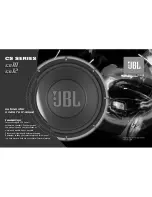
People using microphones should ideally stand directly next to or behind speakers in order to prevent any
problems with feedback. Standing in front of a speaker will almost always result in the sound of the speaker
itself also being picked up by the microphone.
Using with external equipment
It's possible to use the Onyx subwoofer with external equipment like crossovers, equalisers and speaker
management systems. Bear in mind that using external equipment may change the character of the
speaker's sound.
If you use a speaker management processor or a crossover, it's possible to bypass the subwoofer's internal
crossover. To do so, connect your device directly to the subwoofer and speakers so that they are no longer
connected to each other. The advantage of this setup is that you can determine the crossover frequencies
yourself.
Using in combination with speakers
The Onyx subwoofers work seamlessly with Onyx speakers. The subwoofer should preferably be one size
larger than the Onyx speakers for the perfect setup. The signal from your source (mixer, smartphone, laptop
etc.) should be connected to the subwoofer first and then from the subwoofer to the speakers. This setup
allows the subwoofer to reproduce the low tones while the higher frequencies are passed on the speakers
through the subwoofer's outputs. This allows each part of your sound system to focus on what it does best.
The signal from the speakers can then connected to additional speakers if you want to work with more
speakers and one subwoofer.
If you want a setup with more subwoofers and more speakers, the left and right signals should be separated.
They should still go through the subwoofers first. Use the Link function to connect subwoofers and connect
the speakers to the last subwoofer in the chain via the filtered output. This means that each subwoofer gets
the full signal and can filter out the low frequencies itself. The last subwoofer in the chain will then pass the
filtered signal on the speakers for the best possible sound quality without having to use any external
equipment.
Using external equipment like a speaker processing system gives you additional possibilities when it comes
to tweaking the sound and making adjustments that are pertinent to your situation.
45 Hz boost
The 45 Hz boost function can be activated via a button on the back of the subwoofer. As its name suggests,
it boosts frequencies around 45 Hz giving the bass even more prominence. This can also help to give
background music a fuller sound.
180-degree phase button
The 180-degree phase button is not normally required but can be handy to resolve problems with
frequencies that interfere with one another or cause feedback through speakers. Pressing the button
reverses the phase of the signal.
Crossover switch
The crossover switch has two frequency presets of 80 Hz and 120 Hz. Only frequencies above the set
values will be sent to the speakers via the standard outputs.
Smaller speakers are not as good at handling lower frequencies so when using smaller speakers you should
filter out as many of the lower frequencies as possible by setting the Crossover switch to 120 Hz.
For larger speakers that are 12 or 15 inches in size, for instance, a crossover setting of 80 Hz is suitable.
Frequencies below this value will then be reproduced by the subwoofer while the speakers can reproduce
the mid and higher frequencies.
This is just a guide and may not be the best setup depending on the rest of your equipment and situation. It's
always worth experimenting with settings and listening to the results to find the optimal sound.
The information in this user manual is subject to change at any time without notice.
Version: 1.0
Date of creation and author's initials: 23-09-2017 RV
Revision date and author's initials: -





























